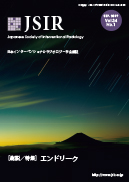Volume 34, Issue 1
Displaying 1-14 of 14 articles from this issue
- |<
- <
- 1
- >
- >|
State of the Art
Endoleaks
-
2019Volume 34Issue 1 Pages 1-
Published: 2019
Released on J-STAGE: September 26, 2019
Download PDF (522K) -
2019Volume 34Issue 1 Pages 2-8
Published: 2019
Released on J-STAGE: September 26, 2019
Download PDF (1207K) -
2019Volume 34Issue 1 Pages 9-20
Published: 2019
Released on J-STAGE: September 26, 2019
Download PDF (2659K) -
2019Volume 34Issue 1 Pages 21-27
Published: 2019
Released on J-STAGE: September 26, 2019
Download PDF (1152K) -
2019Volume 34Issue 1 Pages 28-35
Published: 2019
Released on J-STAGE: September 26, 2019
Download PDF (1269K) -
2019Volume 34Issue 1 Pages 36-45
Published: 2019
Released on J-STAGE: September 26, 2019
Download PDF (1483K) -
2019Volume 34Issue 1 Pages 46-54
Published: 2019
Released on J-STAGE: September 26, 2019
Download PDF (1548K) -
2019Volume 34Issue 1 Pages 55-59
Published: 2019
Released on J-STAGE: September 26, 2019
Download PDF (835K)
Case Reports
-
2019Volume 34Issue 1 Pages 60-63
Published: 2019
Released on J-STAGE: September 26, 2019
Download PDF (890K)
-
2019Volume 34Issue 1 Pages 64-69
Published: 2019
Released on J-STAGE: September 26, 2019
Download PDF (1311K) -
2019Volume 34Issue 1 Pages 70-75
Published: 2019
Released on J-STAGE: September 26, 2019
Download PDF (1218K)
-
2019Volume 34Issue 1 Pages 76-82
Published: 2019
Released on J-STAGE: September 26, 2019
Download PDF (985K)
-
2019Volume 34Issue 1 Pages 83-98
Published: 2019
Released on J-STAGE: September 26, 2019
Download PDF (869K)
-
2019Volume 34Issue 1 Pages 99
Published: 2019
Released on J-STAGE: September 26, 2019
Download PDF (529K)
- |<
- <
- 1
- >
- >|
